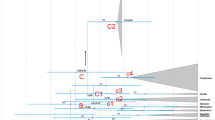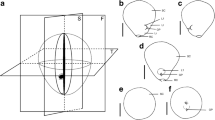Abstract
Carex L. sectionCeratocystis Dumort. is distinct from the closely related sectionSpirostachyae (Drejer) L. Bailey. Differences in pistillate spike morphology, achene shape, and perigynium epidermis are augmented by chemical, cytological, and micromorphological evidence. Character compatibility analysis has been used to reconstruct the phylogenetic history of the sedges in sectionCeratocystis. The resulting network is shown to be robust when tested with cytological, ecological, and micromorphological data not included in its construction. Agmatoploidy has been the dominant process of chromosomal evolution in the section.
Similar content being viewed by others
Literature Cited
Bailey, L. H. 1889. Notes onCarex. XI. Studies of the types of various species of the genusCarex. Mem. Torrey Bot. Club 1: 1–85.
Castro, D. de, A. Camara & N. Malheiros. 1949. X-rays in the centromere problem ofLuzula purpurea Link. Genet. Iber. 1: 49–54.
Chater, A. O. 1980.Carex In: T. G. Tutin et al., editors. Flora Europaea. Vol. 5. Alismataceae to Orchidaceae (Monocotyledones). Cambridge University Press, Cambridge.
Crins, W. J. G. 1985. The taxonomy ofCarex sectionCeratocystis in North America and northern Eurasia. Unpubl. Ph.D. dissertation, Department of Botany, University of Toronto.
Davies, E. W. 1953a. Notes onCarex flava and its allies. I. A. sedge new to the British Isles. Watsonia 3: 66–69.
— 1953b. Notes onCarex flava and its allies. II.Carex lepidocarpa in the British Isles. Watsonia 3: 70–73.
— 1953c. Notes onCarex flava and its allies. III. The taxonomy and morphology of the British representatives. Watsonia 3: 74–79.
— 1953d. Notes onCarex flava and its allies. IV. Geographic distribution. Watsonia 3: 80–84.
— 1955. The cytogenetics ofCarex flava and its allies. Watsonia 3: 129–137.
Drejer, S. 1844. Symbolae Caricologicae. Academia Scientiarum Danica. Hafniae.
Estabrook, G. F. 1977. Does common equal primitive? Syst. Bot. 2: 36–42.
Federov, A. A., editor. 1969. Chromosome numbers in flowering plants. V. L. Komarov Botanical Institute, Academy of Sciences of the U.S.S.R., Leningrad.
Fries, E. 1835. Corpus Florarum Provincialium Sueciae. I. Floram Scanicam. Upsaliae.
Giannasi, D. E. 1978. Systematic aspects of flavonoid biosynthesis and evolution. Bot. Rev. 44: 339–429.
Harborne, J. B. 1971. Distribution and taxonomic significance of flavonoids in the leaves of the Cyperaceae. Phytochemistry 10: 1569–1574.
Heilborn, O. 1924. Chromosome numbers and dimensions, species-formation and phylogeny in the genusCarex. Hereditas 5: 129–216.
— 1939. Chromosome studies in Cyperaceae. III–IV. Hereditas 25: 224–240.
Hermann, F. J. 1971. New species ofCarex from Mexico and Guatemala. Brittonia 23: 144–148.
Holm, T. 1903. Studies in the Cyperaceae. XX. “Greges Caricum”. Amer. J. Sci. Ser. 4, 16: 445–464.
Kreczetovicz, V. 1935.Carex.In: V. L. Komarov, editor. Flora URSS. Vol. 3. Acad. Sci. URSS, Leningrad.
Kükenthal, G. 1909. Cyperaceae—Caricoideae. Das Pflanzenreich 4(20): 1–824.
Mackenzie, K. K. 1935. Cyperaceae—Cariceae. N. Amer. Fl. 18: 1–478.
Meacham, C. A. 1981. A manual method for character compatibility analysis. Taxon 30: 591–600.
— 1984. The role of hypothesized direction of characters in the estimation of evolutionary history. Taxon 33: 26–38.
— & G. F. Estabrook. 1985. Compatibility methods in systematics. Ann. Rev. Ecol. Syst. 16: 431–446.
Nelmes, E. 1952. Facts and speculations on phylogeny in the tribe Cariceae of the Cyperaceae. I. General considerations. Kew Bull. 1951: 427–436.
Palmgren, A. 1959.Carex-gruppenFulvellae Fr. i Fennoskandien. Fl. Fennica 2.
Radford, A. E., W. C. Dickison, W. C. Massey & C. R. Bell. 1974. Vascular plant systematics. Harper and Row, New York.
Savile, D. B. O. & J. A. Calder. 1953. Phylogeny ofCarex in light of parasitism by the smut fungi. Canad. J. Bot. 31: 164–174.
Schmid, B. 1982. Karyology and hybridization in theCarex flava complex in Switzerland. Feddes Repert 93: 23–59.
— 1983. Notes on the nomenclature and taxonomy of theCarex flava group in Europe. Watsonia 14: 309–319.
— 1984. Life histories in clonal plants of theCarex flava group. J. Ecol. 72: 93–114.
Tallent, R. C. & D. E. Wujek. 1983. Scanning electron microscopy as an aid to taxonomy of sedges (Cyperaceae:Carex). Micron Microscopica Acta 14: 271–272.
Vonk, D. H. 1979. Biosystematic studies of theCarex flava complex. I. Flowering Acta Bot. Neerl. 28: 1–20.
Author information
Authors and Affiliations
Rights and permissions
About this article
Cite this article
Crins, W.J., Ball, P.W. Sectional limits and phylogenetic considerations in Carex section Ceratocystis (Cyperaceae). Brittonia 40, 38–47 (1988). https://doi.org/10.2307/2806873
Issue Date:
DOI: https://doi.org/10.2307/2806873




